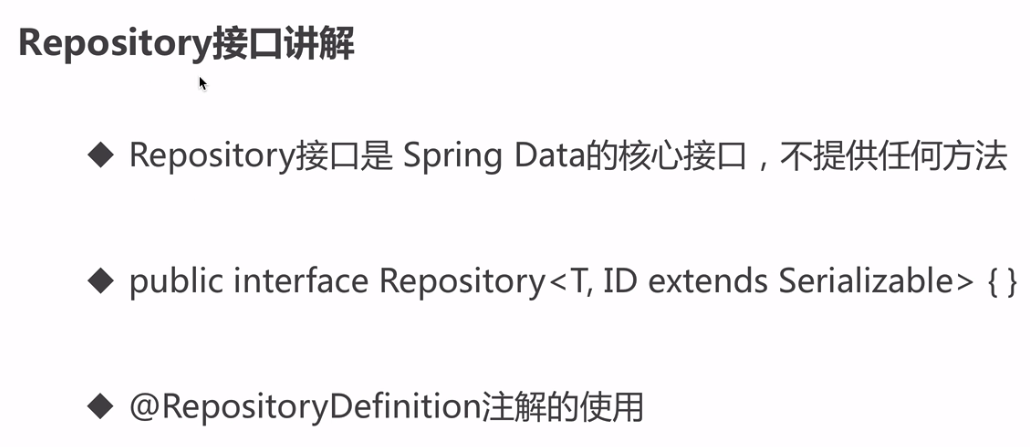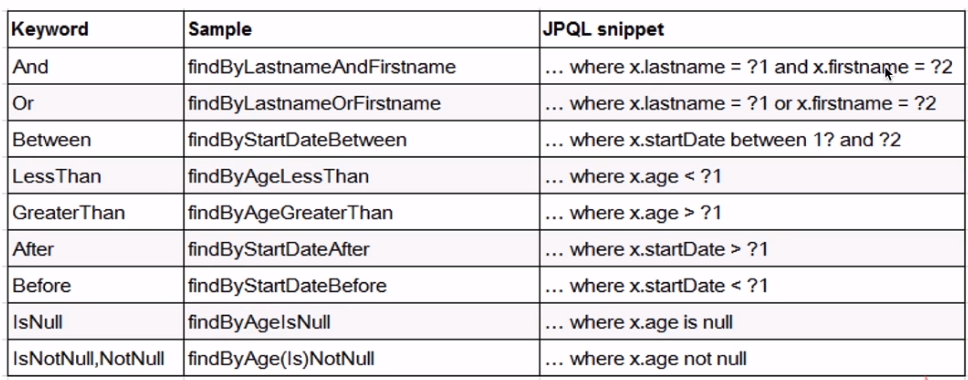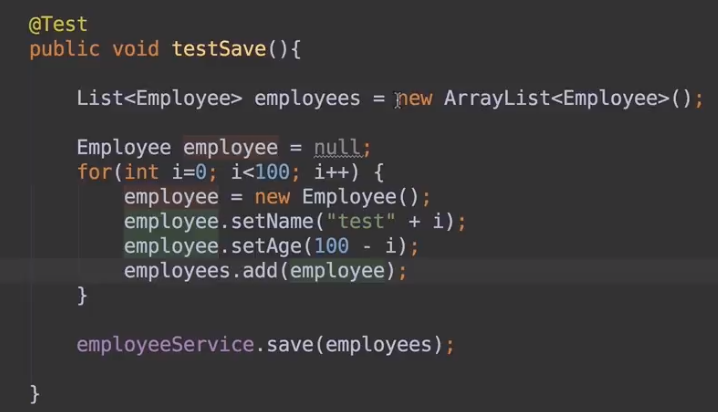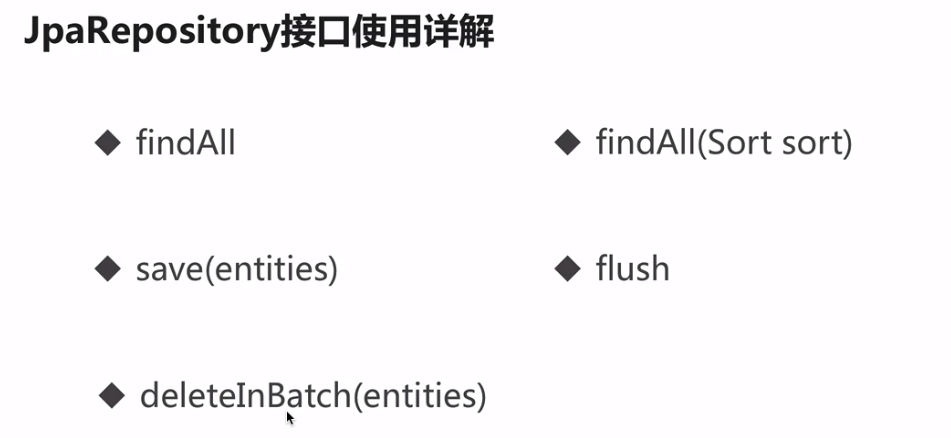主要是参照慕课对springdata jpa 进行一个快速的学习记录,方便以后查看。
视频:https://www.imooc.com/learn/821
一、介绍
SpringData JPA是SpringData中的一个子模块
JPA是一套标准接口,而Hibernate是JPA的实现
SpringData JPA 底层默认实现是使用Hibernate
二、快速开发一个案例
先搭建一个案例 看下效果
1、依赖
<dependencies>
<!--MySQL Driver-->
<dependency>
<groupId>mysql</groupId>
<artifactId>mysql-connector-java</artifactId>
<version>5.1.38</version>
</dependency>
<!--junit-->
<dependency>
<groupId>junit</groupId>
<artifactId>junit</artifactId>
<version>4.10</version>
</dependency>
<!--spring-->
<dependency>
<groupId>org.springframework</groupId>
<artifactId>spring-jdbc</artifactId>
<version>4.3.5.RELEASE</version>
</dependency>
<dependency>
<groupId>org.springframework</groupId>
<artifactId>spring-context</artifactId>
<version>4.3.5.RELEASE</version>
</dependency>
<!--spring data jpa-->
<dependency>
<groupId>org.springframework.data</groupId>
<artifactId>spring-data-jpa</artifactId>
<version>1.8.0.RELEASE</version>
</dependency>
<dependency>
<groupId>org.hibernate</groupId>
<artifactId>hibernate-entitymanager</artifactId>
<version>4.3.6.Final</version>
</dependency>
</dependencies>
2、配置文件
bean.xml
<?xml version="1.0" encoding="UTF-8"?>
<beans xmlns="http://www.springframework.org/schema/beans"
xmlns:xsi="http://www.w3.org/2001/XMLSchema-instance"
xmlns:context="http://www.springframework.org/schema/context"
xmlns:tx="http://www.springframework.org/schema/tx"
xmlns:jpa="http://www.springframework.org/schema/data/jpa"
xsi:schemaLocation="http://www.springframework.org/schema/beans http://www.springframework.org/schema/beans/spring-beans.xsd
http://www.springframework.org/schema/data/jpa http://www.springframework.org/schema/data/jpa/spring-jpa-1.3.xsd
http://www.springframework.org/schema/tx http://www.springframework.org/schema/tx/spring-tx-4.0.xsd
http://www.springframework.org/schema/context http://www.springframework.org/schema/context/spring-context-4.0.xsd">
<!--1 配置数据源-->
<bean id="dataSource" class="org.springframework.jdbc.datasource.DriverManagerDataSource">
<property name="driverClassName" value="com.mysql.jdbc.Driver"/>
<property name="username" value="root"/>
<property name="password" value="root"/>
<property name="url" value="jdbc:mysql:///spring_data"/>
</bean>
<!--2 配置EntityManagerFactory-->
<bean id="entityManagerFactory" class="org.springframework.orm.jpa.LocalContainerEntityManagerFactoryBean">
<property name="dataSource" ref="dataSource"/>
<property name="jpaVendorAdapter">
<bean class="org.springframework.orm.jpa.vendor.HibernateJpaVendorAdapter"/>
</property>
<property name="packagesToScan" value="com.imooc"/>
<property name="jpaProperties">
<props>
<prop key="hibernate.ejb.naming_strategy">org.hibernate.cfg.ImprovedNamingStrategy</prop>
<prop key="hibernate.dialect">org.hibernate.dialect.MySQL5InnoDBDialect</prop>
<prop key="hibernate.show_sql">true</prop>
<prop key="hibernate.format_sql">true</prop>
<!--自动创建表 -->
<prop key="hibernate.hbm2ddl.auto">update</prop>
</props>
</property>
</bean>
<!--3 配置事务管理器-->
<bean id="transactionManager" class="org.springframework.orm.jpa.JpaTransactionManager">
<property name="entityManagerFactory" ref="entityManagerFactory"/>
</bean>
<!--4 配置支持注解的事务-->
<tx:annotation-driven transaction-manager="transactionManager"/>
<!--5 配置spring data-->
<jpa:repositories base-package="com.xx" entity-manager-factory-ref="entityManagerFactory"/>
<context:component-scan base-package="com.xx"/>
</beans>
3、实体类
/** * 雇员: 先开发实体类===>自动生成数据表 */ @Entity //生成表的时候 表明就是类的名字
@Table(name = "mytable") //@Table可以自定义表名 public class Employee { private Integer id; private String name; private Integer age;
//主键和策略 @GeneratedValue @Id public Integer getId() { return id; } public void setId(Integer id) { this.id = id; } //指定字段长度 @Column(length = 20) public String getName() { return name; } public void setName(String name) { this.name = name; } public Integer getAge() { return age; } public void setAge(Integer age) { this.age = age; } }
4、自定义Repository接口
//自定义接口实现Repository 泛型内容分别是 实体类 和 主键类型 public interface EmployeeRepository extends Repository<Employee,Integer>{ //来一个查询方法 public Employee findByName(String name); } 也可以用注解的方式,如下 @RepositoryDefinition(domainClass = Employee.class, idClass = Integer.class) public interface EmployeeRepository { ... }
5、测试
只有一个接口 没有实现类
public class EmployeeRepositoryTest {
private ApplicationContext ctx = null;
private EmployeeRepository employeeRepository = null;
@Test
public void testFindByName() {
employeeRepository = ctx.getBean(EmployeeRepository.class);
Employee employee = employeeRepository.findByName("zhangsan");
System.out.println("id:" + employee.getId()
+ " , name:" + employee.getName()
+ " ,age:" + employee.getAge());
}
}
只要我们实现了Repository接口,我们就可以使用"按照方法命名规则"来进行查询 ,也就是说findByName这个方法名是不能乱改的,室友规律的。
这样一个简单案例就搭建出来了。
三、详细说明
1、repository接口

Repository类的定义:
public interface Repository<T, ID extends Serializable> {
}
1)Repository是一个空接口,标记接口
没有包含方法声明的接口
2)如果我们定义的接口EmployeeRepository extends Repository 就说明我们自定义的会被spring管理 所以上面案例可以直接getBean
如果我们自己的接口没有extends Repository,运行时会报错:
org.springframework.beans.factory.NoSuchBeanDefinitionException: No qualifying bean of type 'com.imooc.repository.EmployeeRepository' available
3) 添加注解能到达到不用extends Repository的功能
@RepositoryDefinition(domainClass = Employee.class, idClass = Integer.class)
2、repository子接口

3、repository查询方法定义规则和使用


使用命名规则查询
// where name like ?% and age <?
public List<Employee> findByNameStartingWithAndAgeLessThan(String name, Integer age);
// where name like %? and age <?
public List<Employee> findByNameEndingWithAndAgeLessThan(String name, Integer age);
// where name in (?,?....) or age <?
public List<Employee> findByNameInOrAgeLessThan(List<String> names, Integer age);
// where name in (?,?....) and age <?
public List<Employee> findByNameInAndAgeLessThan(List<String> names, Integer age);
对于按照方法命名规则来使用的话,有弊端:
1)方法名会比较长: 约定大于配置
2)对于一些复杂的查询,是很难实现
4、@Query注解

@Query注解中写sql语句 但是查的不是表名 是表对应的实体类名。
@Query("select o from Employee o where id=(select max(id) from Employee t1)")
public Employee getEmployeeByMaxId();
@Query("select o from Employee o where o.name=?1 and o.age=?2")
public List<Employee> queryParams1(String name, Integer age);
@Query("select o from Employee o where o.name=:name and o.age=:age")
public List<Employee> queryParams2(@Param("name")String name, @Param("age")Integer age);
@Query("select o from Employee o where o.name like %?1%")
public List<Employee> queryLike1(String name);
@Query("select o from Employee o where o.name like %:name%")
public List<Employee> queryLike2(@Param("name")String name);
使用原生SQL 加上 nativeQuery = true属性
这里面的from后边跟的就是表名了
@Query(nativeQuery = true, value = "select count(1) from employee")
public long getCount();
5、更新、删除结合事务
事务在Spring data中的使用:
1)事务一般是在Service层
2)@Query、 @Modifying、@Transactional综合使用
EmployeeRepository.java
@Modifying
@Query("update Employee o set o.age = :age where o.id = :id")
public void update(@Param("id")Integer id, @Param("age")Integer age);
EmployeeService.java
@Service
public class EmployeeService {
@Autowired
private EmployeeRepository employeeRepository;
@Transactional
public void update(Integer id, Integer age) {
employeeRepository.update(id, age);
}
}
四、Repository的子接口的使用
1、CrudRepository

- 自定义Repository 实现CrudRepository接口

- service:


- 测试

2、PagingAndSortingRepository

- dao

- 分页测试

当前是第几页 因为是从0开始的 所以显示的时候可以加上1

- 分页加排序测试
- Order的第一个参数是按照什么方式排序(例如 升序、降序) 第二个参数是根据那个字段排序

3、JpaRepository

接口

测试略
4、JpaSpecificationExecutor
为什么使用这个接口 ,是因为其他几个基于 Repository的子接口 在分页查询 排序时不能加查询条件

使用这个类可以加查询条件

cb.gt(...)代表年龄大于50的条件


第二个参数是pageable 没有截出来
这样的话加上了限制条件 最后返回的是一个page,就可以拿数据了
